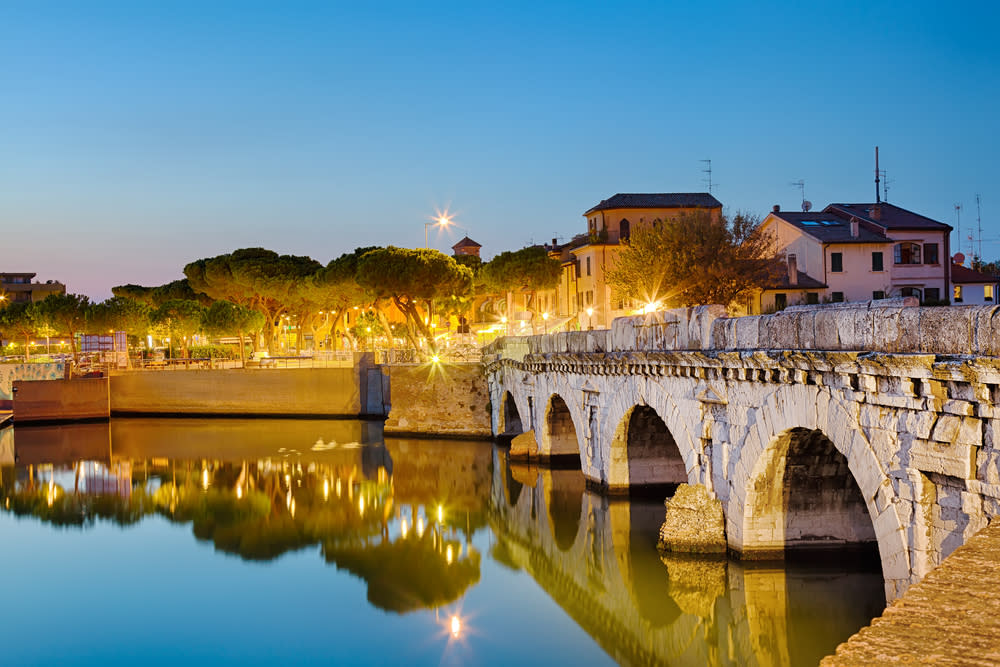More from Rimini
Main Menu
- 00:00
- 06:00
- 12:00
- 18:00
- 23:00
Rimini : Next 24-Hour Weather
Today - 17th April 2025
Sunrise 06:23
Sunset 19:56
Tomorrow - 18th April 2025
Sunrise 06:23
Sunset 19:56
Holiday Weather Now
Sorted by popularity:
Updated at 02:00 GMT
-
Temp feels like16°C61°F
-
Length of day13h 33m
-
Pressure29" (1001 hpa)
-
Visibility10 km (6miles)
-
Wind speed22 km/h
Sunrise 06:23
Sunset 19:56
-
Temp feels like:
16ºC (61 ºF)
-
Length of day:
13h 33m
-
Pressure:
29" (1001 hpa)
-
Visibility:
6 miles (10 km)
-
Wind speed:
22 km/h
Rimini is a city located on Italyâs Adriatic coast, in the Emilia-Romgna region in the north-east of the country. It is perhaps the best-known resort on the Adriatic coast and is home to many Roman and Medieval buildings and landmarks.
<?xml:namespace prefix = o ns = "urn:schemas-microsoft-com:office:office" />
Rimini experiences a temperate climate with cool winters and hot summers.
Summer (mid-May to August) is hot and sunny, with occasional rain and some humidity. Summer arrives in mid-May when temperatures reach an average of 22°C. May also sees plenty of sunshine, with a daily average of eight hours expected. The weather can be extremely pleasant, and visitors during May can avoid the very hot temperatures of late summer while still enjoying plenty of sunshine. Rainfall of 53mm means showers can punctuate the sunny weather, but May is actually one of the drier months.
June, July and August experience the hottest of the summer weather. Average temperatures hit 25°C in June and rise to 28°C in July and August. This is accompanied by plenty of sunshine, with average daily levels of nine or ten hours in each of these months. The days are long, and visitors can expect most days to be filled with hot sunshine â" ideal for relaxing on the sandy beaches. Sea temperatures get quite warm thanks to the Adriaticâs sheltered position, and temperatures peak at 26°C in August.
Northern Italy is often very humid during the summer, but this is less true of Rimini thanks to its location on the coast.
Rainfall is fairly uniform year-round, and June, July and August experience moderate rainfall levels of between 51mm (June) and 66mm (August), so heavy showers can occasionally interrupt the sunny weather.
Autumn (September and October) is warm but fairly wet. September remains quite hot, with average temperatures of 24°C, but an average of 72mm of rain. October is somewhat cooler, averaging 19°C, and similarly wet. However, plenty of pleasant weather can be expected, particularly in September when visitors can expect a very respectable seven hours of sunshine daily.
Winter (November to February) can get quite cold. November temperatures average 13°C, and the weather can be quite gloomy. November is the wettest month of the year, seeing 82mm of rainfall. December and January are the coldest months of the year, averaging 7°C and 8°C during the daytime. Temperatures can drop dramatically at night, and night-time averages are 1°C and 0°C respectively, so it can get extremely cold at night. Snow is common at any time between December and February.
In spring (March to mid-May) the weather can be very pleasant. March starts off quite chilly, with average daytime temperatures of 13°C. Night-times can be quite cold - the average night-time temperature in March is just 4°C. April sees temperatures rise considerably to an average of 17°C, but nights can still be pretty chilly. Both months can experience frost during the night. Both March and April see moderate rainfall of between 54mm and 59mm.
Early May can experience very warm weather, similar to summer levels. Average is 22°C, but this can get close to 30°C at times.

















